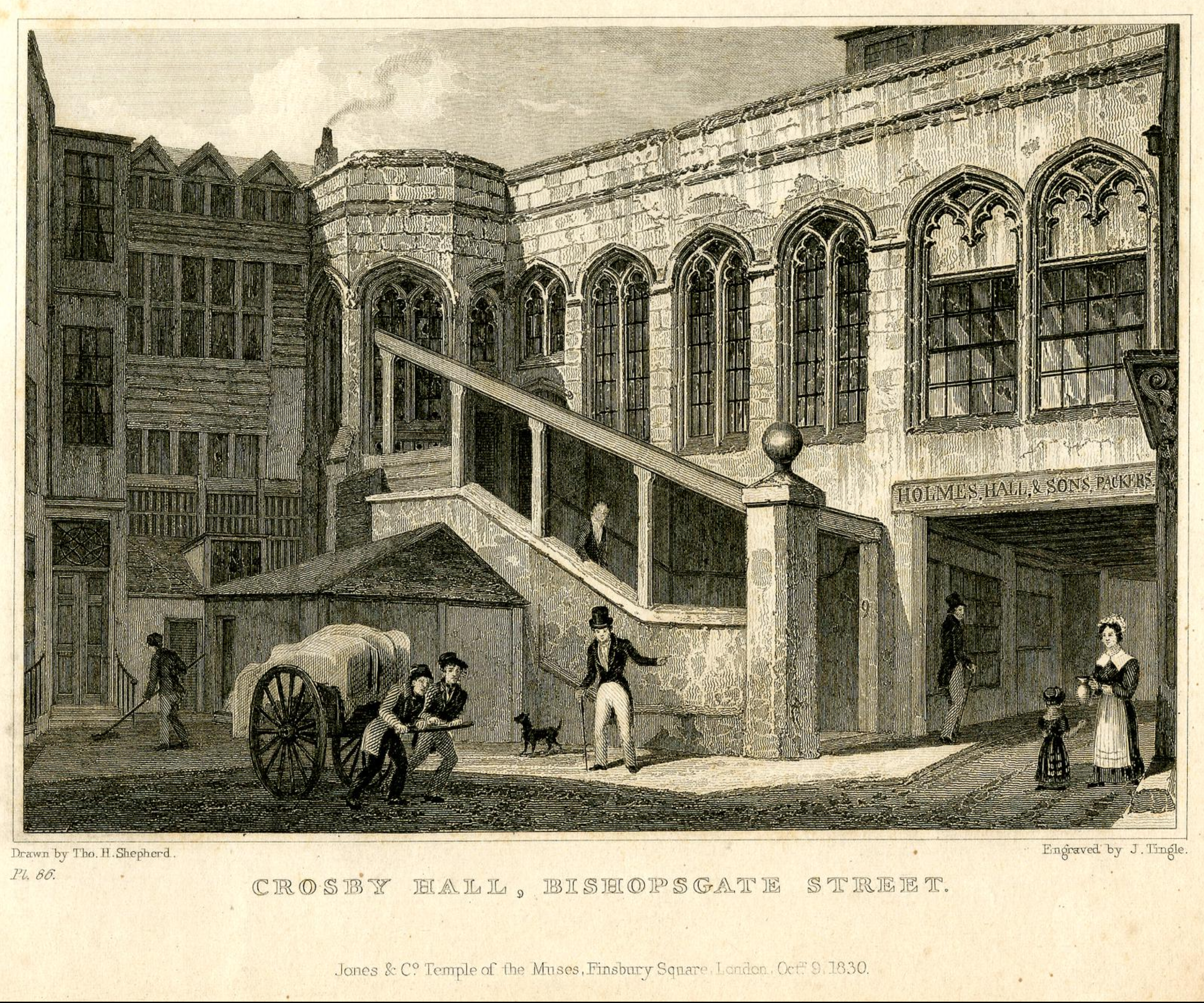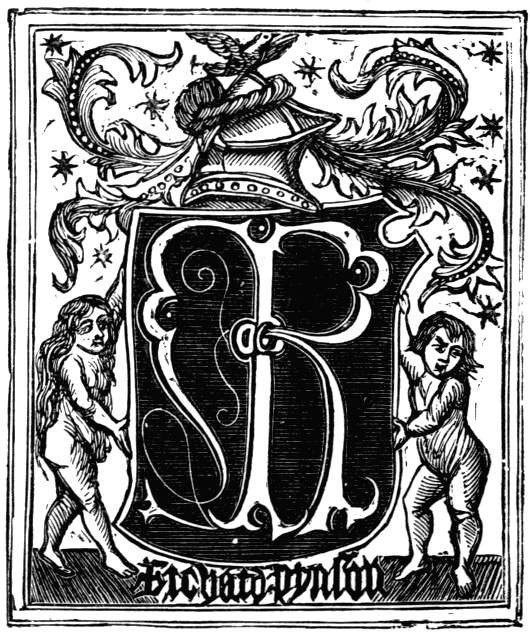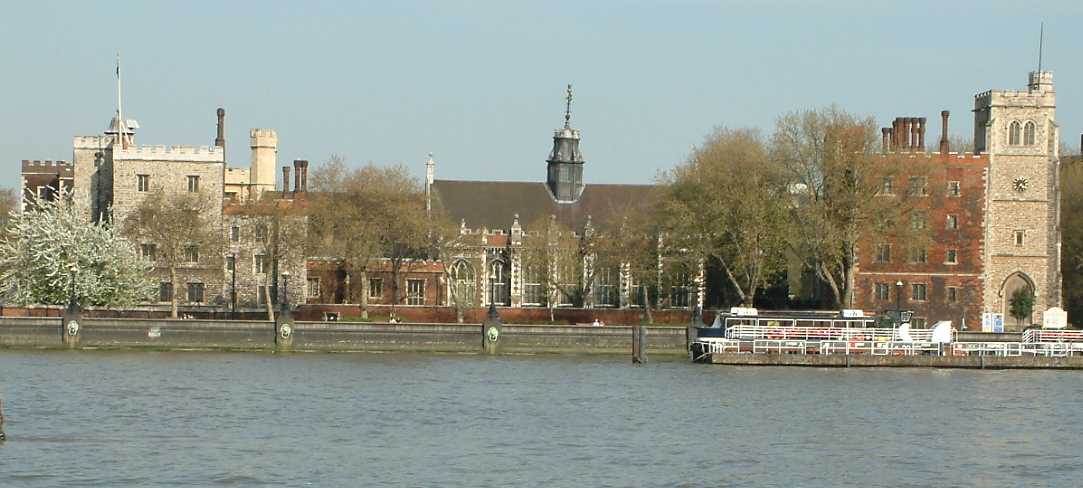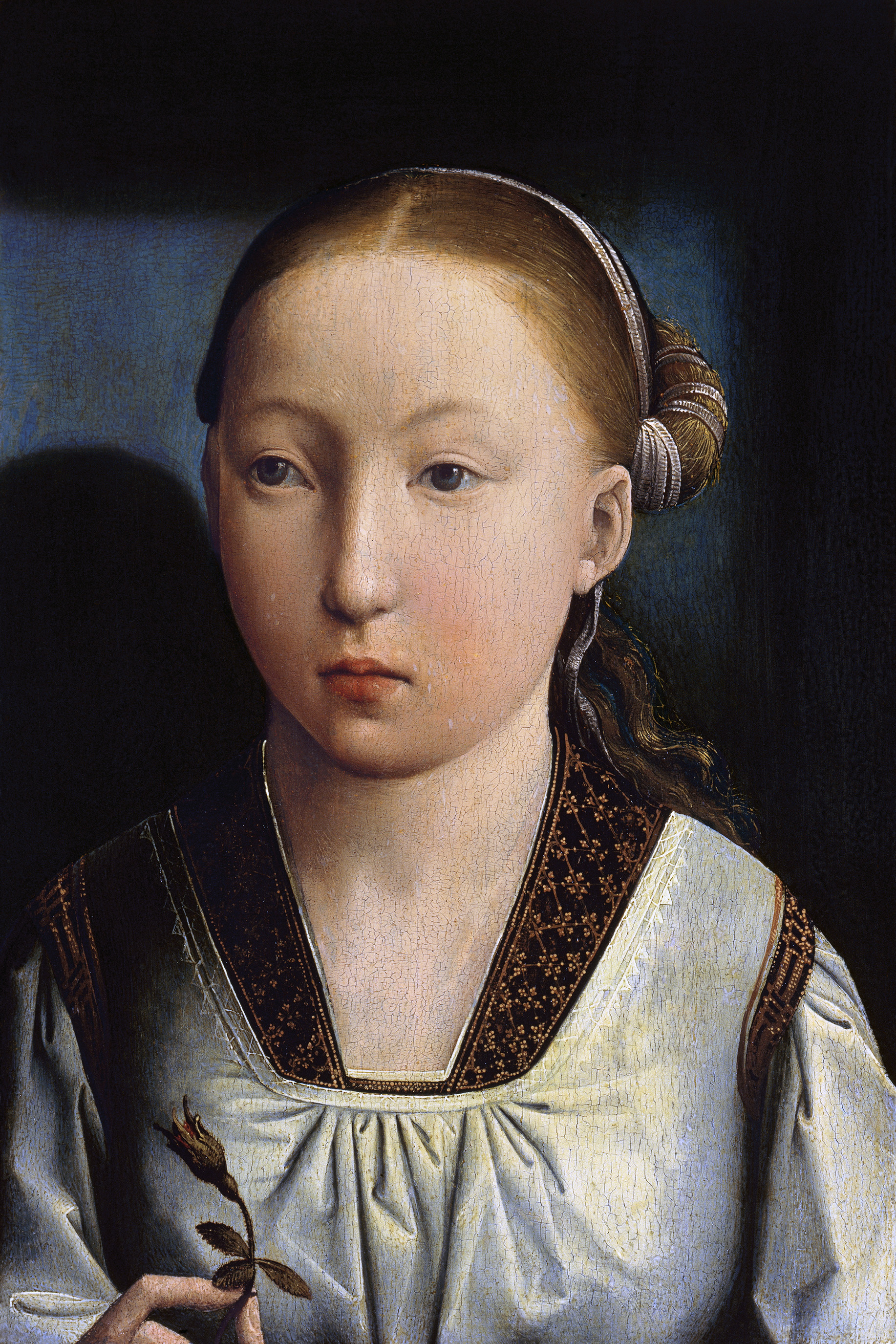|
Crosby Hall, London
Crosby Hall is a historic building in London. The Great Hall was built in 1466 and originally known as Crosby Place in Bishopsgate, in the City of London. It was moved in 1910 to its present site in Cheyne Walk, Chelsea. It now forms part of a private residence, which in 2021 was renamed Crosby Moran Hall. The Great Hall, and additional work of 1910 and 1925–1926, are listed Grade II*. Although fragmentary and not on its original site, this is the only example of a medieval City merchant house surviving in London. Between 1988 and 2021 it was restored, and further buildings added, to create the present complex. The Great Hall is considered to be the most important surviving secular domestic medieval building in London. History Bishopsgate The Great Hall is the only surviving part of the medieval mansion of Crosby Place, Bishopsgate, in the City of London. It was built in 1466 on the grounds of St. Helen's Convent across from St. Helen's Church, Bishopsgate (Coordinates: ... [...More Info...] [...Related Items...] OR: [Wikipedia] [Google] [Baidu] |
Gable
A gable is the generally triangular portion of a wall between the edges of intersecting roof pitches. The shape of the gable and how it is detailed depends on the structural system used, which reflects climate, material availability, and aesthetic concerns. The term gable wall or gable end more commonly refers to the entire wall, including the gable and the wall below it. Some types of roof do not have a gable (for example hip roofs do not). One common type of roof with gables, the gable roof, is named after its prominent gables. A parapet made of a series of curves ( Dutch gable) or horizontal steps ( crow-stepped gable) may hide the diagonal lines of the roof. Gable ends of more recent buildings are often treated in the same way as the Classic pediment form. But unlike Classical structures, which operate through trabeation, the gable ends of many buildings are actually bearing-wall structures. Gable style is also used in the design of fabric structures, with varying d ... [...More Info...] [...Related Items...] OR: [Wikipedia] [Google] [Baidu] |
Robert Fabyan
Robert Fabyan (died 1512) was a London draper, Sheriff and Alderman, and author of ''Fabyan's Chronicle''. Family Robert Fabyan was the son of John Fabyan and his wife, Agnes. He is said to have been born in London. He had a brother, John. His nephew, John Fabyan, married Anne Waldegrave, by whom he had a daughter, Mary Fabian, wife of Sir Thomas Spert. Career He was apprenticed as a draper to William Holme about 1470, and was granted the freedom of the Worshipful Company of Drapers in 1476. In 1485 he served as renter warden of the Drapers, and in 1486 as auditor of the accounts of the City of London. In 1493 he was elected Sheriff, and in the following year as alderman of the ward of Farringdon Without. In 1495 he was elected Master of the Drapers, and in 1496 was chosen to petition Henry VII on behalf of the Company with respect to the levies on cloth exported from England to Flanders. During the Cornish Rebellion of 1497 Fabyan, John Brooke and John Warner were charged wit ... [...More Info...] [...Related Items...] OR: [Wikipedia] [Google] [Baidu] |
Thomas More
Sir Thomas More (7 February 1478 – 6 July 1535), venerated in the Catholic Church as Saint Thomas More, was an English lawyer, judge, social philosopher, author, statesman, and noted Renaissance humanist. He also served Henry VIII as Lord High Chancellor of England from October 1529 to May 1532. He wrote ''Utopia'', published in 1516, which describes the political system of an imaginary island state. More opposed the Protestant Reformation, directing polemics against the theology of Martin Luther, Huldrych Zwingli, John Calvin and William Tyndale. More also opposed Henry VIII's separation from the Catholic Church, refusing to acknowledge Henry as supreme head of the Church of England and the annulment of his marriage to Catherine of Aragon. After refusing to take the Oath of Supremacy, he was convicted of treason and executed. On his execution, he was reported to have said: "I die the King's good servant, and God's first". Pope Pius XI canonised More in 1935 as a martyr. ... [...More Info...] [...Related Items...] OR: [Wikipedia] [Google] [Baidu] |
Lambeth Palace
Lambeth Palace is the official London residence of the Archbishop of Canterbury. It is situated in north Lambeth, London, on the south bank of the River Thames, south-east of the Palace of Westminster, which houses Parliament, on the opposite bank. History While the original residence of the Archbishop of Canterbury was in his episcopal see, Canterbury, Kent, a site originally called the Manor of Lambeth or Lambeth House was acquired by the diocese around AD 1200 and has since served as the archbishop's London residence. The site is bounded by Lambeth Palace Road to the west and Lambeth Road to the south, but unlike all surrounding land is excluded from the parish of North Lambeth. The garden park is listed and resembles Archbishop's Park, a neighbouring public park; however, it was a larger area with a notable orchard until the early 19th century. The former church in front of its entrance has been converted to the Garden Museum. The south bank of the Thames along ... [...More Info...] [...Related Items...] OR: [Wikipedia] [Google] [Baidu] |
Evil May Day
Evil May Day or Ill May Day is the name of a xenophobic riot which took place in 1517 as a protest against foreigners (called "strangers") living in London. Apprentices attacked foreign residents ranging from "Flemish cobblers" to "French royal courtiers". Some of the rioters were later hanged although King Henry VIII granted a pardon for the remainder following public pleadings from his wife, Catherine of Aragon. Causes Demographics of Tudor London In the early part of the reign of King Henry VIII, Londoners came to resent the presence of foreigners (called "strangers") arriving from the continent, especially immigrant Flemish workers and the wealthy foreign merchants and bankers of Lombard Street. At the time, only about 2% of London's population of approximately 50,000 were foreign-born. Role of "Dr Bell" According to the chronicler Edward Hall (c. 1498–1547), a fortnight before the riot an inflammatory xenophobic speech was made on Easter Tuesday by a preacher kn ... [...More Info...] [...Related Items...] OR: [Wikipedia] [Google] [Baidu] |
Maximilian I, Holy Roman Emperor
Maximilian I (22 March 1459 – 12 January 1519) was King of the Romans from 1486 and Holy Roman Emperor from 1508 until his death. He was never crowned by the pope, as the journey to Rome was blocked by the Venetians. He proclaimed himself Elected Emperor in 1508 ( Pope Julius II later recognized this) at Trent, thus breaking the long tradition of requiring a Papal coronation for the adoption of the Imperial title. Maximilian was the son of Frederick III, Holy Roman Emperor, and Eleanor of Portugal. Since his coronation as King of the Romans in 1486, he ran a double government, or ''Doppelregierung'' (with a separate court), with his father until Frederick's death in 1493. Maximilian expanded the influence of the House of Habsburg through war and his marriage in 1477 to Mary of Burgundy, the ruler of the Burgundian State, heir of Charles the Bold, though he also lost his family's original lands in today's Switzerland to the Swiss Confederacy. Through marriage of his son ... [...More Info...] [...Related Items...] OR: [Wikipedia] [Google] [Baidu] |
Bartholomew Reade
Sir Bartholomew Reade (or Rede; died 1505) was an English goldsmith and politician who served as Lord Mayor of London. Family Reade was born in Cromer, Norfolk. His parents were Roger Reade (d. 1470) and his wife Catherine, and he had at least two siblings, John and Simon. He was already well-established in London by 1486, when he is mentioned in his mother's will as a "citizen and goldsmith of London". Rye, Walterbr>"Cromer, Past and Present"pg. 51 Offices Reade, a goldsmith, was for several years the Master of the Mint. Along with Lord Daubeney, he was commissioned to mint the first gold sovereigns in 1489. He was one of the Sheriffs of London in 1497. Two years later, he was alderman of the ward of Aldersgate. He was elected Lord Mayor of London in 1502, succeeding fellow goldsmith John Shaa. During his mayoralty, he used Crosby Place, which he had acquired in 1501, as his hall. He is recorded as throwing extravagant feasts for ambassadors sent by Emperor Maximilian. ... [...More Info...] [...Related Items...] OR: [Wikipedia] [Google] [Baidu] |
Henry VII Of England
Henry VII (28 January 1457 – 21 April 1509) was King of England and Lord of Ireland from his seizure of the crown on 22 August 1485 until his death in 1509. He was the first monarch of the House of Tudor. Henry's mother, Margaret Beaufort, was a descendant of the House of Lancaster, Lancastrian branch of the House of Plantagenet. Henry's father, Edmund Tudor, 1st Earl of Richmond, a half-brother of Henry VI of England and a member of the Welsh Tudors of Penmynydd, died three months before his son Henry was born. During Henry's early years, his uncle Henry VI was fighting against Edward IV, a member of the Yorkist Plantagenet branch. After Edward retook the throne in 1471, Henry Tudor spent 14 years in exile in Duchy of Brittany, Brittany. He attained the throne when his forces, supported by Kingdom of France, France, Scotland, and Wales, defeated Edward IV's brother Richard III at the Battle of Bosworth Field, the culmination of the Wars of the Roses. He was the last king of ... [...More Info...] [...Related Items...] OR: [Wikipedia] [Google] [Baidu] |
Arthur, Prince Of Wales
Arthur, Prince of Wales (19/20 September 1486 – 2 April 1502), was the eldest son of King Henry VII of England and Elizabeth of York. He was Duke of Cornwall from birth, and he was created Prince of Wales and Earl of Chester in 1489. As the heir apparent of his father, Arthur was viewed by contemporaries as the great hope of the newly established House of Tudor. His mother, Elizabeth, was the daughter of Edward IV, and his birth cemented the union between the House of Lancaster and the House of York. Plans for Arthur's marriage began before his third birthday; he was installed as Prince of Wales two years later. At the age of eleven, he was formally betrothed to Catherine of Aragon, a daughter of the powerful Catholic Monarchs in Spain, in an effort to forge an Anglo-Spanish alliance against France. Arthur was well educated and was in good health for the majority of his life. Soon after his marriage to Catherine in 1501, the couple took up residence at Ludlow Castle in ... [...More Info...] [...Related Items...] OR: [Wikipedia] [Google] [Baidu] |
Catherine Of Aragon
Catherine of Aragon (also spelt as Katherine, ; 16 December 1485 – 7 January 1536) was Queen of England as the first wife of King Henry VIII from their marriage on 11 June 1509 until their annulment on 23 May 1533. She was previously Princess of Wales as the wife of Henry's elder brother, Arthur, Prince of Wales. The daughter of Isabella I of Castile and Ferdinand II of Aragon, Catherine was three years old when she was betrothed to Prince Arthur, heir apparent to the English throne. They married in 1501, but Arthur died five months later. Catherine spent years in limbo, and during this time, she held the position of ambassador of the Aragonese crown to England in 1507, the first known female ambassador in European history. She married Arthur's younger brother, the recently ascended Henry VIII, in 1509. For six months in 1513, she served as regent of England while Henry VIII was in France. During that time the English crushed and defeated a Scottish invasion ... [...More Info...] [...Related Items...] OR: [Wikipedia] [Google] [Baidu] |
John Stow
John Stow (''also'' Stowe; 1524/25 – 5 April 1605) was an English historian and antiquarian. He wrote a series of chronicles of English history, published from 1565 onwards under such titles as ''The Summarie of Englyshe Chronicles'', ''The Chronicles of England'', and ''The Annales of England''; and also ''A Survey of London'' (1598; second edition 1603). A. L. Rowse has described him as "one of the best historians of that age; indefatigable in the trouble he took, thorough and conscientious, accurate – above all things devoted to truth". Life John Stow was born in about 1525 in the City of London parish of St Michael, Cornhill, then at the heart of London's metropolis. His father, Thomas Stow, was a tallow chandler. Thomas Stow is recorded as paying rent of 6s 8d per year for the family dwelling, and as a youth Stow would fetch milk every morning from a farm on the land nearby to the east owned by the Minoresses of the Convent of St. Clare. There is no evidence that h ... [...More Info...] [...Related Items...] OR: [Wikipedia] [Google] [Baidu] |





_1.312_-_Beginning_of_the_Riot_in_Cheapside.jpg)




